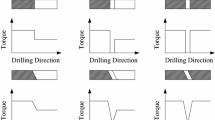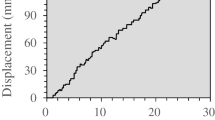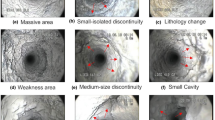Abstract
Ground conditions, including characteristics of fractures, joints, bed separations, and strengths of rock layers, are critical factors for proper design of openings in underground mining and construction projects. Correct understanding of geologic conditions allows for improvement and optimization of ground support design and minimizing incidents of ground failure and instabilities in underground workings. Rock bolts have been widely accepted as the preferred method of ground support in almost all forms of rock excavation applications. The concept of monitoring drilling data to evaluate characteristics of geological features of interest in the rock surrounding the underground opening is a very attractive option for developing the geological model of the ground on real-time basis. This includes information on distributions of joints and bed separations, locations of voids, and strengths of rock layers, which enables the automated and rapid evaluation of ground conditions while drilling is in progress. Several smart drilling systems have been developed and proposed to detect joints; however, they offer limited capabilities and have exhibited difficulties in identifying joints with small apertures. The current study was focused on developing a more sensitive method to locate joints with smaller apertures along the hole being drilled with an instrumented roof bolter. A series of full-scale drilling tests were carried out in samples which contained simulated joints with different inclined angles in controlled laboratory conditions. New joint detection programs, with improved capabilities based on various pattern recognition algorithms, have been developed and used for analysis of data recorded in the full-scale drilling tests. To precisely locate joints, composite parameter was also used to offer more accurate detection. This paper reviews the laboratory testing program, data analysis, logic/algorithms used in the programs, statistical analysis of the detection results, and comparison of the various algorithms for this application.












Similar content being viewed by others
References
Anderson R, Prosser LJ (2007) Improving the capability for real time assessment of roof conditions through intelligent roof bolt drilling operations. Proceedings of 26th International Conference on Ground Control in Mining, Morgantown, WV, August 2007, pp 287–292
Bahrampour S, Rostami J, Ray A, Naeimipour A, Collins G (2015) Ground characterization and roof mapping using online change detection. Int J Min Sci Technol 25:905–913
Barr VM (1984) Instrumented horizontal drilling for tunnelling site investigations. Ph.D. Thesis, Imperial College of Science and Technology, London, UK
Basseville M, Nikiforov IV (1993) Detection of abrupt changes: theory and application, vol 104. Prentice Hall, Englewood Cliffs
Bishop CM (2006) Pattern recognition and machine learning. Springer, Berlin
Brown ET, Barr MV (1978) Instrumented drilling as an aid to site investigations. In Proceedings of the 3rd International Congress of the International Association of Engineering Geology, Madrid, Spain, 4–8 September, pp 21–28
Collins CM, Wilson G, Tang D, Peng S (2004) Field testing of a real time roof mapping drilling display system in a limestone mine. Proceedings of 23rd International Conference on Ground Control in Mining, Morgantown, WV, August 2004
Duda R, Hart P, Stork D (2012) Pattern classification, 2nd edn. Wiley, USA
Finfinger G, Peng S, Gu Q, Wilson G, Thomas B (2000) An approach to identifying geological properties from roof bolter drilling parameters. In: Proceedings of the 19th International Conference on Ground Control in Mining. Morgantown, WV: West Virginia University, pp 1–12
FitzSimmons JR, Stateham RM, Radcliffe DE (1979) Flexible, fiberoptic stratascope for mining applications. Rep Investig 8345:12
Frizzell EM, Howie WL (1990) Roof Bolter—New source of low-cost roof strata information. SME Annual Meeting, Salt Lake City, Utah, February 26, March 1, pp 17–22
Frizzell EM, Howie WL, Smelser TW (1992) Automated geophysical sensing and data processing roof drill. In: Proceedings of 23rd International Symposium on the Application of Computers and Operations Research in the Minerals Industries (APCOM), Arizona, USA, 1992, pp 297–305
Ghosh R, Schunnesson H, Gustafson A (2017) Monitoring of drill system behavior for water-powered in-the-hole (ITH) drilling. Minerals 7:121
Gong Q, Zhao J, Jiao Y (2005) Numerical modeling of the effects of joint orientation on rock fragmentation by TBM cutters. Tunn Undergr Space Technol 20:183–191
Hassanpour J, Rostami J, Zhao J (2011) A New hard rock TBM performance prediction model for project planning. Tunn Undergr Space Technol 26(5):595–603
Hatherly P, Leung R, Scheding S, Robinson D (2015) Drill monitoring results reveal geological conditions in blasthole drilling. Int J Rock Mech Min Sci 78:144–154
Hill JRM, Smelser TW, Signer SP, Miller GG (1993) Intelligent drilling system for geological sensing. Proceedings of 1993 EEE/RSJ International Conference on Intelligent Robots and Systems Yokohama, Japan July 1993, pp 495–501
Itakura K, Sato K, Deguchi G, Ichihara Y, Matsumoto H, Eguchi H (1997) Development of a roof-logging system by rockbolt drilling. Trans Inst Min Metall (Sect A Min Technol) 106:118–123
Kahraman S, Rostami J, Naeimipour A (2016) Review of ground characterization by using instrumented drills for underground mining and construction. Rock Mech Rock Eng 49:585–602
Khorzoughi MB, Hall R, Apel D (2018) Rock fracture density characterization using measurement while drilling (MWD) techniques. Int J Min Sci Technol 28:859–864
King RL, Hicks MA, Signer SP (1993) Using unsupervised learning for feature detection in a coal mine roof. Eng Appl Artif Intell 6(6):565–573
Liu W, Rostami J, Keller E (2017) Application of new void detection algorithm for analysis of feed pressure and rotation pressure of roof bolters. Int J Min Sci Technol 27:77–81
Liu W, Rostami J, Elsworth D, Ray A (2018) Application of composite indices for improving joint detection capabilities of instrumented roof bolt drills in underground mining and construction. Rock Mech Rock Eng 51:849–860
Mahtab MA, Bolstad OD, Pulse RR (1973) Determination of attitudes of joints surveyed with a borescope in inclined boreholes. US Bureau of Mines. Inf Circ 8615:12
Murphy KP (2012) Machine learning: a probabilistic perspective. The MIT Press, Cambridge
Neyman J, Pearson ES (1933) The testing of statistical hypotheses in relation to probabilities a riori. Mathematical Proceedings of the Cambridge Philosophical Society Vol 29, pp 492–510
Page ES (1954) Continuous inspection schemes. Biometrika 41:100–115
Peck R, Devore JL (2011) Statistics: the exploration and analysis of data. Cengage Learn:464–465
Peng S, Tang D, Mirabile B, Luo Y, Wilson G (2003). Mine roof geology information system (MRGIS). In: Proceedings of the 22nd International Conference on Ground Control in Mining. Morgantown, WV: West Virginia University, pp 127–135
Posiva (2010) Investigation ahead of the tunnel face by use of a measurement-while-drilling system at Olkiluoto, Finland. Working Report 2010–2015: 22–32. Available at: http://www.posiva.fi/files/1214/WR_2010-05web.pdf
Rai P, Schunesson H, Lindqvist PA, Kumar U (2015) An overview on measurement-while-drilling technique and its scope in excavation industry. J Inst Eng (India) 96:57–66
Rostami J, Naeimipour A, Bahrampour S, Dogruoz C (2014) Logging of roofbolt boreholes for ground characterization in underground construction. In: Proceedings of World Tunneling Conference, Iguasso Falls, Brazil, May 10–15, 2014
Rostami J, Kahraman S, Naeimipour A, Collins C (2015) Rock characterization while drilling and application of roof bolter drilling data for evaluation of ground conditions. J Rock Mech Geotech Eng 7:273–281
Schunnesson H, Kristoffersson T (2011) Rock mass characterization using drill and crushability monitoring—A case study. Int J COMADEM 14:44–52
Sheskin DJ (2004) Handbook of parametric and nonparametric statistical procedures. CRC Press, Boca Raton, p 54
Signer SP, King R (1992) Evaluation of coal mine roof supports using artificial intelligence. 23rd International Symposium 1992—Application of Computers and Operations Research, pp 889–985
Takach GA, Morris SP, Miller GG (1992). A control system for roof drilling. Proceedings of 3rd International Symposium on the Application of Computers and Operations Research in the Minerals Industries (APCOM), Arizona, USA, 1992, pp 277–285
Tang X, Doug P (2005). Analyzing and processing acoustic logging data for poorly-bonded cased boreholes. 2005 Annual Logging Symposium, SPWLA, pp 1–11
Tarkoy PJ, Marconi M (1991) Difficult rock comminution and associated geological conditions. In: Tunneling 91, Sixth International Symposium, 14–18 April 1991, Hovotel, London, England, Institute of Mining and Metallurgy, Elsevier Applied Science, London, pp. 195–207
Unrug K F (1994) Realistic design of ground control based on geotechnical data obtained during mine development. Proceedings of the 13th International Conference on Ground Control in Mining, August 2–4, Morgantown, WV, pp 227–232
Williams JH, Johnson CD (2004) Acoustic and optical borehole-wall imaging for fractured-rock aquifer studies. J Appl Geophys 55(1–2):151–159
Acknowledgements
This research was funded by a Grant from National Institute of Occupational Safety and Health (NIOSH) ground control group under the contract No. 211-2011-41138. The authors would like to acknowledge contributions from J.H. Fletcher staff and engineers, including Greg Collins, Joe McQuerrey, Lyle Crum, Edwin Lewis Warnick IV, and Brad Parks. The authors would like to express their gratitude to these above contributors and appreciate help from Dr. Eric Keller, Dr. Ali Naeimipour, and Soheil Bahrampour in this research.
Author information
Authors and Affiliations
Corresponding author
Additional information
Publisher's Note
Springer Nature remains neutral with regard to jurisdictional claims in published maps and institutional affiliations.
Rights and permissions
About this article
Cite this article
Liu, W., Rostami, J., Ray, A. et al. Statistical Analysis of the Capabilities of Various Pattern Recognition Algorithms for Fracture Detection Based on Monitoring Drilling Parameters. Rock Mech Rock Eng 53, 2265–2278 (2020). https://doi.org/10.1007/s00603-019-01965-8
Received:
Accepted:
Published:
Issue Date:
DOI: https://doi.org/10.1007/s00603-019-01965-8




